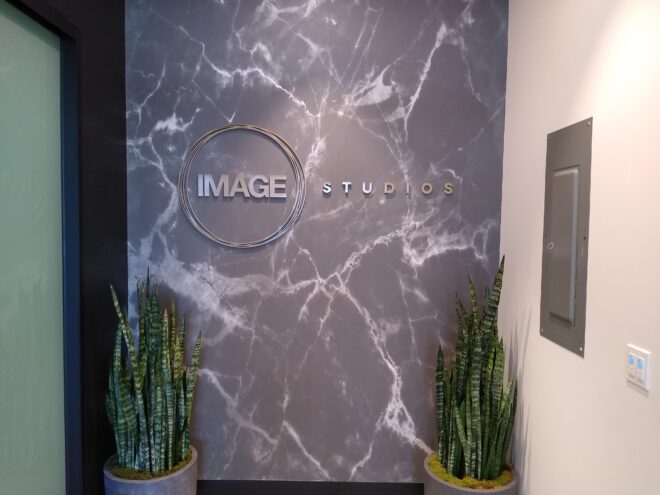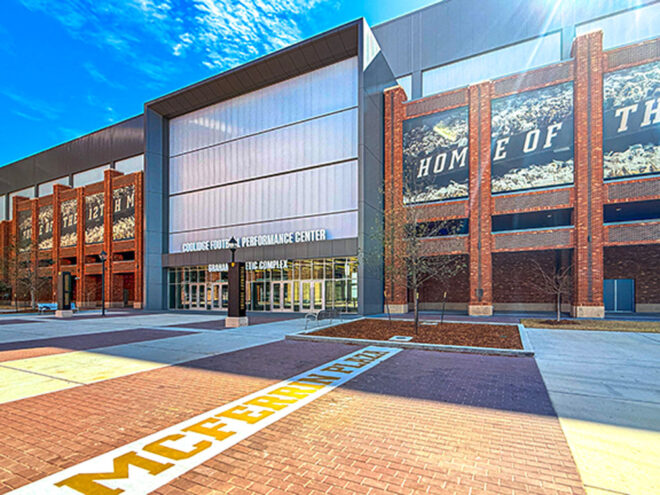3 Factors to Consider When Designing for Interiors and Exterior Signage

When it comes to interior and exterior signage, understanding how each space affects materials, design, and installation is essential for long-term success and client satisfaction. From high-traffic lobbies to coastal building exteriors, let’s explore considerations of interior signage design versus exterior signage design, with expert input from Gemini’s team and Signs from Mars.
“The biggest difference to consider between interior and exterior signage is how the finish and materials are going to wear,” explains Linda Lopez, Sr. Layout Help Desk at Gemini. “Conditions like sun, heat, water, salt, and even the substrate signs are installed on can cause the finish or protective coatings to fail prematurely.”
Asking your client questions about the installation environment is paramount to the sign’s longevity. The more information you can gather, the better the solution can be tailored. For exterior installs in high-exposure environments—like signage near landscaping, water features, or high-humidity zones—it’s important to inform your manufacturer early. This allows for adjustments to materials and coatings that help improve long-term durability and performance.

For example, exterior signage—especially in coastal or humid climates—anodized aluminum or 316 stainless steel might be recommended. Likewise, specific coatings like Flash Bronze are best reserved for indoor use, as the finish will deteriorate with prolonged UV exposure.
If you’re helping a client decide whether to update or replace signage, check out Replace or Repair: Tips for Updating Exterior Signage.


Mars Bravo from Signs from Mars emphasizes that interior signage requires a different mindset. As outlined in her perspective, these signs are often viewed from a close distance, under controlled lighting, and within intentional architectural environments.
“Interior signage isn’t just about labeling a space or pointing directions—it’s often the first branded message someone sees after they’ve already stepped inside,” Bravo notes. That means finishes, lighting, and proportion need to be flawless.
Key considerations from Mars’ insight include:
- Finish = First Impression: Imperfections in paint or gloss are easily visible indoors. Mars recommends matte finishes for highlight areas and gloss for soft-lit, high-end spaces.
- Lighting: Mismatched light temperatures (warm vs. cool) can make signage appear low-quality or unintentional.
- Proportion: Scaling signage to the wall size and maintaining white space keeps the message impactful and refined.
- Design for Multiple Angles: Use spacers, balanced letter thickness, and shadows to add dynamic appeal.

Unlike the refined detail of interior signage, exterior signage must prioritize visibility, durability, and long-term performance. Outdoor signs are exposed to UV rays, moisture, wind, and temperature swings, making material choice and mounting strategy essential to success.
Sign installation considerations—like substrate compatibility, hardware selection, and exposure to the elements—play a significant role in ensuring a sign’s longevity. For example, signage installed on brick or concrete requires different preparation than signage mounted on drywall or glass. Skipping these steps can lead to premature wear or failure.
Some of Gemini’s most popular outdoor-ready solutions include:
- Fabricated metal letters for high-impact, dimensional branding
- Illuminated signage for 24/7 visibility
- Wayfinding signage to help people navigate large campuses and outdoor facilities
These signs also need to command attention from a distance. That means bold fonts, high-contrast finishes, and sizing suited to outdoor viewing conditions.
When time is a factor, Gemini’s flat cut acrylic and metal products offer fast lead times while still meeting the demands of exterior use, giving sign shops flexibility without sacrificing quality.
Considerations for Sign Shops
Here are design considerations for sign professionals based on the project installation environment:
| Interior Signage | Exterior Signage | |
| Design Focus | Detail, lighting, proportion | Visibility, scale, and weather resistance |
| Material Needs | Precision finishes, softer textures | Durable materials, UV-resistant coatings |
| Inspection | Eye-level viewing, longer dwell time | Viewed from afar, often while in motion |
| Installation | Seamless hardware | Substrate-dependent, must withstand elements |
Signs Built for The Environment
Interior and exterior signage tell a story, but the medium and installation considerations reflect the environment. Whether working on lobby signs or exterior branding, design choices should be grounded in the context of the installation environment, longevity, and the client’s expectations.
Gemini works with sign professionals across North America to specify the right product for every project. From helping identify the best products for the project to choosing the right lighting approach, our goal is to make work easier and results more successful.
Getting started with your interior or exterior dimensional signage project? Contact us to learn how to get started as an authorized Gemini partner or request a quote.





